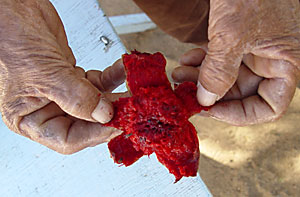 |
|
Photo Courtesy of DAVID YETMAN
|
Vicente Tajia peals a ripe pitaya also known as organ pipe cactus fruit.
|
|
|
By Zach Colick
Arizona Daily Wildcat
Thursday, March 31, 2005
Print this
By working together, researchers at the UA's Southwest Center and the Masiaca indigenous community of southern Sonora, Mexico created two reserves set aside for the protection and conservation of one of the world's biggest cacti forests.
Both UA and Masiaca's researchers are entering the fourth year of their multi-disciplinary program of cacti conservation, research and community development in El Pitayal.
David Yetman, a social science researcher at the Southwest Center and director of the project, said he helped establish both a 62-acre preserve created in 2001 and a new 500-acre preserve to conserve the organ pipe-shaped cacti, which can soar more than 40 feet high.
Yetman said both organ pipe cacti reserves have been protected and fenced off by the Masiaca community, who patrol the fences and monitor the conditions inside the reserves to safeguard the cacti from roaming cattle.
Of equal importance is the livelihood that local comuneros, or community members, in El Pitayal receive from the organ pipe forests.
Jeff Banister, the Southwest Center's outreach coordinator for Mexico, and Yetman brought Mexican and American specialists to El Pitayal to assist the community in making consumer products from the pitaya, or the fruit of the organ pipe cacti, which needs ample summer sunlight and a good rain season for growth.
After three years of experimenting, community members came up with recipes for preparing organ pipe mermelada (jam) and cuero (fruit leather) to sell.
Rainy Warf, the UA economic development specialist for the project, said she helps facilitate and develop strategies to market the cacti fruit products around the Masiaca community.
"The goals of the project are to preserve the cacti forests and to build economic success for the Masiaca's," Warf said.
Though there are people who sell the jam and fruit leather alongside highways in the United States, Warf said it is a time-consuming process because the fruit has to be sold that day or it spoils.
Warf said the Southwest Center plans to sell the fruit products in the United States over the summer if they meet the national U.S. Department of Agriculture health standards.
Yetman said economic development and conservation must go hand-in-hand in the preservation of the cacti forests in order to sell the fruits of their labor.
Otherwise, Yetman said, the businessmen in the area would like nothing more than to see the destruction of the cacti forests for their own personal gain.
"Many comuneros view the great cacti as a critically important resource, but others would rather see them bulldozed and lease the land for shrimp farming," Yetman said. "We have to convince a majority of the comuneros that the intact forest is an egalitarian, profitable resource that will last forever."
The organ pipe cactus produces millions of fruits called pitaya, which can be produced in less than 48 hours, beginning in mid-July through late September, with the fruit being an important annual food source for the Masiaca people of the region, Yetman said.
"The livelihood of several dozen families depends on the plants that are grown in the El Pitayal region," Yetman said.
Yetman said the Southwest Center's project role is limited because they provide resources the Masiacas could not otherwise find but let them run the project otherwise.
"It's their brains behind the whole thing," Yetman said. "They call the shots and bring life to the project."
Besides the Southwest Center, the work is being funded largely by the Wallace Research Foundation and the Robidoux Foundation.
"In essence, we're paying rent in borrowing the land to offset their losses from the major cattle industry that they depend on for income," Yetman said.
